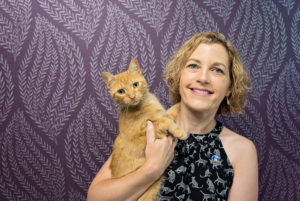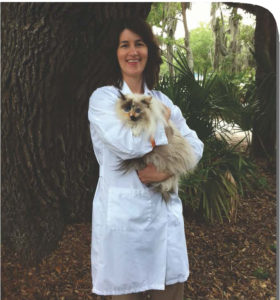Surfing the web today I came across an online review directed at a veterinary hospital and a specific veterinarian in a small community. Reading it made me angry, but then I realized that I don’t have to remain silent. This review was not about me or about my practice, but it quite easily could have been. In fact, it has been about me in the past and like many veterinarians, I too have been victim to negative reviews, online slander and even bullying in my small community.
For 27 years, as a vet, I chose to “take the high road” and remained silent. Refusing to respond to the negative and slanderous online trolls, I tried to grow a thick skin and focus on staying positive. Only those closest to me know how much it hurt and how I struggled to not let those comments eat away at my confidence.
I still recall the experience as a new practice owner, of a truly hateful and slanderous campaign aimed at harming our small business and turning our new community against us. I was invited by a friend to join an evening painting group. I love to draw and paint, but starting a family and buying a small business had left me little free time to pursue my hobbies. I decided it was time to do something for myself and agreed to join my friend.
I introduced myself to the group as just “Elaine” and being new to the community, most of the members did not know I was “Dr. Elaine”, a veterinarian. As people worked on their art, and chatted with each other, I felt my stomach tighten as the talk turned to pets and then a discussion of local veterinarians. Opinions about local veterinarians were bantered about and then my stomach knotted as things suddenly took a nasty turn. I listened in shock, as people discussed the smear campaign of posters that were being placed around the community “exposing” the terrible new veterinarians that had recently started a practice. This was the first I had heard about this slanderous campaign and I was afraid and hurt.
With a tremor in my voice, I stood up and re-introduced myself as “Dr. Elaine Klemmensen.” I heard a collective gasp go through the room and sat back down to a room of stunned silence. I continued to paint while trying to figure out how I could get the heck out of there! Thankfully I was saved by my pager buzzing. One of the few times in my career I was happy to get called in for an after-hours emergency.
Everyone is entitled to their opinion and what I am talking about here is not respectful dialogue and open communication aimed at resolving a conflict or misunderstanding. I am talking about mean and spiteful slander aimed at harming an individual and or their business. There is a difference, and for years I ignored those trolls and refused to respond for two reasons: First, it seemed unprofessional and petty to respond. Second, I did not want to get drawn into the negative drama and chose instead, to protect myself and stay positive. I opted to focus my energies on the people and things I cared about in life and let the haters hate. It is far too easy in veterinary medicine to dwell on the negative outcomes, the negative clients and the negative reviews. It’s difficult to not let that one mean, unhappy client or coworker, ruin your day while forgetting about the 20 amazing people that put a smile on your face.
So, to all of you out there who have posted unfair, biased and downright mean reviews about your vet, rants aimed to hurt or damage their reputation with no desire to understand or resolve your issue, wake up take responsibility for your choices. When you adopted that pet, you took on the financial responsibility for that animal. It isn’t your vets responsibility to subsidize the cost of medical care for you. It isn’t your veterinarian or their team’s fault when it is injured or ill. As hard as we try, as skilled as we may be, we cannot save every patient. We cannot foresee every complication and while we are doing our best, at the end of the day we are only human. Stop making your vet feel guilty if they want to earn a fair salary for the 60+ hours a week they work and for heaven’s sake stop telling them they’re “only in it for the money”. Frankly this phrase is getting pretty old for all of us so show a little creativity and come up with something new already. Oh, and one more thing, if you are going to slander us or our team online at least have the courage to sign your real name. If you have a problem with our care or our service just talk to us – face to face, like a grownup.
When my son was in grade 5, he was the target of some school yard bullying. We talked about it and encouraged him to not react, to pretend it didn’t bother him, essentially to turn the other cheek. True to his nature, he listened, digested this information and then decided to handle it his way. This involved tossing the said bully across the room and ending up in the principal’s office. We were called in to the school to discuss our son’s anger management issues and true to our non-confrontational nature, we listened and did not say what was on our minds, something I have always regretted. Where were the other kids parents? Is it okay to constantly taunt someone with mental abuse until they snap? Thankfully his teacher gave our son the support we did not, when several weeks later, he asked him how things were going. Our lad replied that things were much better for him after he threw the kid across the room. The teacher just looked at him meaningfully and said “Sometimes you just gotta do, what you gotta do”.
Maybe it is time to stand up and do what we gotta do.
The views and opinions expressed in this article are those of the author and do not necessarily reflect the position of the DrAndyRoark.com editorial team.
 ABOUT THE AUTHOR
ABOUT THE AUTHOR
A small animal practice owner for 20 years, Elaine recently sold her practice and hit the road to volunteer in far flung places around the globe. When not spaying dogs in the bush in Africa, she works as a locum in Canada and loves writing about her adventures at www.vetswithoutboundaries.com with the hopes of inspiring veterinarians to embrace change, try something new and build a life that brings them joy.

